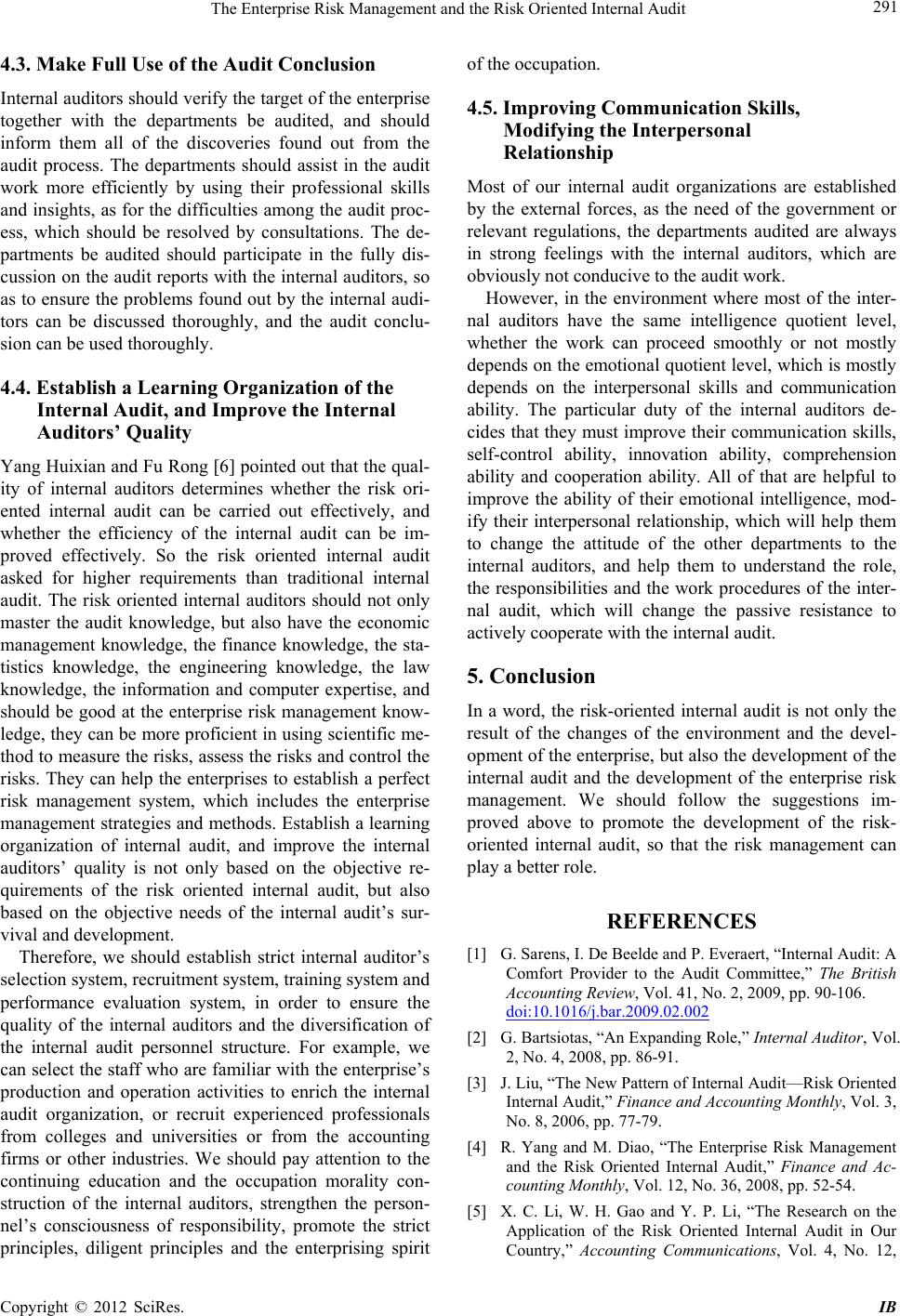
The Enterprise Risk Management and the Risk Oriented Internal Audit 291
4.3. Make Full Use of the Audit Conclusion
Internal auditors should verify the target of the enterprise
together with the departments be audited, and should
inform them all of the discoveries found out from the
audit process. The departments should assist in the audit
work more efficiently by using their professional skills
and insights, as for the difficulties among the audit proc-
ess, which should be resolved by consultations. The de-
partments be audited should participate in the fully dis-
cussion on the audit reports with the internal auditors, so
as to ensure the problems found out by the internal audi-
tors can be discussed thoroughly, and the audit conclu-
sion can be used thoroughly.
4.4. Establish a Learning Organization of the
Internal Audit, and Improve the Internal
Auditors’ Quality
Yang Huixian and Fu Rong [6] pointed out that the qual-
ity of internal auditors determines whether the risk ori-
ented internal audit can be carried out effectively, and
whether the efficiency of the internal audit can be im-
proved effectively. So the risk oriented internal audit
asked for higher requirements than traditional internal
audit. The risk oriented internal auditors should not only
master the audit knowledge, but also have the economic
management knowledge, the finance knowledge, the sta-
tistics knowledge, the engineering knowledge, the law
knowledge, the information and computer expertise, and
should be good at the enterprise risk management know-
ledge, they can be more proficient in using scientific me-
thod to measure the risks, assess the risks and control the
risks. They can help the enterprises to establish a perfect
risk management system, which includes the enterprise
management strategies and methods. Establish a learning
organization of internal audit, and improve the internal
auditors’ quality is not only based on the objective re-
quirements of the risk oriented internal audit, but also
based on the objective needs of the internal audit’s sur-
vival and development.
Therefore, we should establish strict internal auditor’s
selection system, recruitment system, training system and
performance evaluation system, in order to ensure the
quality of the internal auditors and the diversification of
the internal audit personnel structure. For example, we
can select the staff who are familiar with the enterprise’s
production and operation activities to enrich the internal
audit organization, or recruit experienced professionals
from colleges and universities or from the accounting
firms or other industries. We should pay attention to the
continuing education and the occupation morality con-
struction of the internal auditors, strengthen the person-
nel’s consciousness of responsibility, promote the strict
principles, diligent principles and the enterprising spirit
of the occupation.
4.5. Improving Communication Skills,
Modifying the Interpersonal
Relationship
Most of our internal audit organizations are established
by the external forces, as the need of the government or
relevant regulations, the departments audited are always
in strong feelings with the internal auditors, which are
obviously not conducive to the audit work.
However, in the environment where most of the inter-
nal auditors have the same intelligence quotient level,
whether the work can proceed smoothly or not mostly
depends on the emotional quotient level, which is mostly
depends on the interpersonal skills and communication
ability. The particular duty of the internal auditors de-
cides that they must improve their communication skills,
self-control ability, innovation ability, comprehension
ability and cooperation ability. All of that are helpful to
improve the ability of their emotional intelligence, mod-
ify their interpersonal relationship, which will help them
to change the attitude of the other departments to the
internal auditors, and help them to understand the role,
the responsibilities and the work procedures of the inter-
nal audit, which will change the passive resistance to
actively cooperate with the internal audit.
5. Conclusion
In a word, the risk-oriented internal audit is not only the
result of the changes of the environment and the devel-
opment of the enterprise, but also the development of the
internal audit and the development of the enterprise risk
management. We should follow the suggestions im-
proved above to promote the development of the risk-
oriented internal audit, so that the risk management can
play a better role.
REFERENCES
[1] G. Sarens, I. De Beelde and P. Everaert, “Internal Audit: A
Comfort Provider to the Audit Committee,” The British
Accounting Review, Vol. 41, No. 2, 2009, pp. 90-106.
doi:10.1016/j.bar.2009.02.002
[2] G. Bartsiotas, “An Expanding Role,” Internal Auditor, Vol.
2, No. 4, 2008, pp. 86-91.
[3] J. Liu, “The New Pattern of Internal Audit—Risk Oriented
Internal Audit,” Finance and Accounting Monthly, Vol. 3,
No. 8, 2006, pp. 77-79.
[4] R. Yang and M. Diao, “The Enterprise Risk Management
and the Risk Oriented Internal Audit,” Finance and Ac-
counting Monthly, Vol. 12, No. 36, 2008, pp. 52-54.
[5] X. C. Li, W. H. Gao and Y. P. Li, “The Research on the
Application of the Risk Oriented Internal Audit in Our
Country,” Accounting Communications, Vol. 4, No. 12,
Copyright © 2012 SciRes. IB